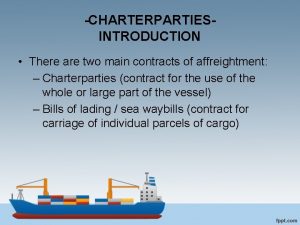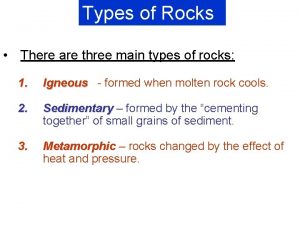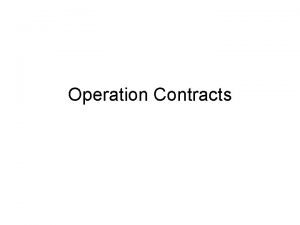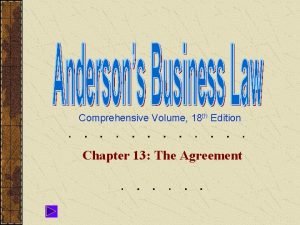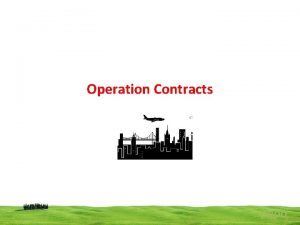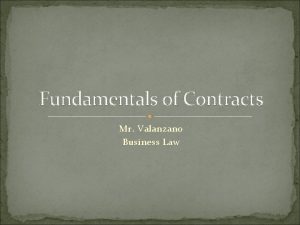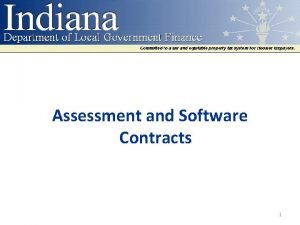CHARTERPARTIESINTRODUCTION There are two main contracts of affreightment
























- Slides: 24

-CHARTERPARTIESINTRODUCTION • There are two main contracts of affreightment: – Charterparties (contract for the use of the whole or large part of the vessel) – Bills of lading / sea waybills (contract for carriage of individual parcels of cargo)

DEFINITION OF CHARTERPARTIES • The term ‘charter party’ derives from Latin words “carta partita” which means “contract divided” • The old practice : when a contract was finalised and written, the original document incorporating the terms and conditions of the contract was cut into 2 halves; one half to be kept by the charterer and the other half by the shipowner. This was done to prevent fraud in the original document.

• Charterer – a person that is entitled to the use of the ship. • The ship is “to be chartered” or “under charter”.

TYPES OF CHARTERPARTIES Bareboat/demise charterparties Voyage charterparties Time charterparties

1. Bareboat charterparties • Contracts which give the charterer full control of the vessel for an agreed period in exchange for the payment of hire. • Charterer provides his own crew and is answerable for the acts of master and crew. • The charterer is responsible for the operating cost of the ship (e. g. crew, bunkers, port costs etc).

• Bareboat charters are used in following circumstances: – By governments requiring vessel, notably in time of war. – By shipowners that need to supplement an existing fleet and who want total control over the vesse (subject to limitation in c/p) – As an instrument of ship finance.

Example of situation for bareboat charterparties • A contract for the purchase of ship by installment will often incorporate a bareboat charter into the contract. • A financing bank lend the funds required to buy a ship. Thus, it acquires ownership of the ship. The bank bareboat chartering the ship to the borrower for the period of the laon.

2. Voyage charters • Contracts for the use of ship to carry an agreed to carry specific goods on one or more voyages between named ports in exchange for the payment of freight. • Normally, (unless there is an express terms to the contrary) shipowner is responsible for all the operating costs of the ship. [technical & commercial operation]

3. Time charters • Contracts for the use of the ship for a specified period of time in exchange for the payment of hire. • The owner pays for the crew and the cost of insuring the ship and responsible for the vessel’s fitness to trade. [technical operation] • The charterer normally pays for bunkers, port charges and cargo handling expenses (stevedoring costs, agencies, pilotages) and “all other usual expenses. ” [commercial operation] • The vessel may be sub-chartered to another charterer or the charterer may contract for the cariage of goods.

Allocation of costs (Shipowner’s account) VOYAGE CHARTER TIME CHARTER Crew wages Provision (food) Stores & Equipment Lubricating oil Repairs Surveys Management overhead Fuel/bunker Port charges Pilotages Stevedores / hold cleaning (*depends on contract) Dunnage Risk of bad weather (delays)

Allocation of costs (Charterer’s account) VOYAGE CHARTER TIME CHARTER Freight Hire Stevedores Fuel/bunker Port charges Pilotages Stevedores / hold cleaning Dunnage Risk of bad weather (delays)

Who bears the risk of delay? Types of carterparty Risk of Delay Solution TIME CHARTER Charterer Off-hire VOYAGE CHARTER Shipowner Demurrage

** Time charter contains ‘off hire clause’ which provides that hire is not payable by the charterer during any period when full use of the vessel is not available to him due to circumstances which are attributable to the shipowner or the vessel e. g. engine failure or crew deficiencies or drydocking or defective loading equipment. **Demurrage: ü A liquidated damages clause in a voyage charterparty for all time used in loading or discharging cargo from the vessel after the expiry of laytime. ü Demurrage is calculated as an agreed rate per day. **Laytime: ü The contractual time or period of time given by the shipowner or carrier to a voyage charterer for the loading or discharging of the cargo. ü It is the period the shipowner or carrier undertakes to make and keep the vessel available for loading or discharging without payment additional to the freight.

When Does Laytime Start to Run? 1. The chartered vessel must have become an ‘arrived ship’ at the agreed destination. 2. Notice of readiness (NOR) must have been given. 3. The vessel must in fact be ready to load. ** NOR is a notice by the shipowner to the charterer or other person as required by the charterparty that the ship has arrived at the berth/port and is ready to load or discharge cargo)

When is the Ship “an Arrived Ship”? ü depends on the wording of the charterparty. Ø If the charter is a berth charter, the ship is an arrived ship on reaching the loading or discharging berth. Ø If the charter is a port charter she is an arrived ship on reaching the usual waiting anchorage within the legal and commercial limits of the port of loading or discharge.

Additional forms of charteparties • Slot charterparty: an agreement which enables liner operators to utilise empty space on their ships by allowing other operators to use some of the empty carrying capacity in their vessel in exchange for the right to use an equivalent amount of space on the ships of such other operators. • Trip time charter: a charter of a vessel for a specific voyage but on time charter terms. The charterer pays hire for whatever the duration of the voyage to be.

CHARTERING STRATEGY • If the market rate of hire goes down, the owner will have benefited from the time charter. • If the market rate of hire goes up, the charter will have benefited from the time charter. The time charter will prevent the owner from exploiting the higher market rate.

WHEN IS THERE A BINDING CONTRACT ? • The formation of charterparty is governed by the normal principles of general contract law. • A charter party is concluded when the offer made by the offeror is accepted by the offeree. • There is no formal requirement under the common law that a contract must be in writing. • However, writing is important as evidence of the terms of the contract.

• Until all terms have been agreed either party can withdraw from further negotiations without penalty. • Even when all the details have been agreed, if the fixture is subject to some other condition e. g. “subject stem” or “subject board approval”, there is no binding fixture until that condition has been satisfied within the time given to do so.

TERMS OF THE CONTRACT • Terms may be express or implied.

EXPRESS TERMS UNDER CHARTERPARTY • Express terms of c/p are terms contained in the c/p contracts. • The terms deal with matters such as period of the charter, the rate of the freight/hire, the loading, carriage and discharge of goods, the allocation of cost for loading and discharge operations, demurrage rate, off-hire, payment of commission.

• There are various forms of charterparties used by merchants. ü Some forms are intended for general trading. Ø Baltime 1939 (Bimco Uniform Time-Charter) , Ø Gencon 1994 Ø New York Produce Exchange Form (NYPE) • Others are intended for a specific type of trade: -BPTIME (tanker), - BPVOY SHELLLNGTIM(LNG), -COALVOY(coal), - C “ORE” 7 (iron ore), -SUGARCHARTER (sugar).

IMPLIED TERMS UNDER CHARTERPARTY • Some obligations are automatically incorporated into the contract by the courts in the absence of agreement to the contrary. • Such obligations are derived from a common source in the law merchant. • The ability of the parties to exclude the operation of these terms by mutual agreement has been restricted.

These obligations are: ON THE PART OF SHIPOWNER • To provide a seaworthy ship. • Obligation of reasonable despatch. • Obligation not to deviate from the agreed route ON THE PART OF CHARTERER • Obligation to nominate a safe port • Obligation not to ship dangerous goods
 Insidan region jh
Insidan region jh Freightment imbler
Freightment imbler Future going to
Future going to Stated and implied main idea
Stated and implied main idea Void main int main
Void main int main Types of rock quiz
Types of rock quiz Main effect vs interaction
Main effect vs interaction What are the 3 main types of sentences?
What are the 3 main types of sentences? The high rate of poaching of rhinoceros is due mostly to
The high rate of poaching of rhinoceros is due mostly to Water contracts (gets smaller) when it freezes.
Water contracts (gets smaller) when it freezes. Types of computer contracts
Types of computer contracts Litter picking contracts
Litter picking contracts System operation contracts
System operation contracts International contract
International contract Types of contracts
Types of contracts Forward contract hedging
Forward contract hedging Mailbox rule contracts
Mailbox rule contracts Mailbox rule contracts
Mailbox rule contracts Parts of a contract
Parts of a contract Next-generation smart contracts
Next-generation smart contracts Mailbox rule contracts
Mailbox rule contracts What is contract financing
What is contract financing Immoral contract chapter 1
Immoral contract chapter 1 Mailbox rule contracts
Mailbox rule contracts Normal backwardation
Normal backwardation

